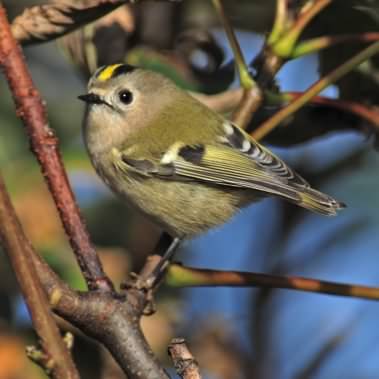
Photo ©2005 Bogbumper
Click photo for a larger image
Goldcrest - Regulus regulus
Family - Regulidae
Also known as - Golden–crowned Kinglet

Photo ©2005 Bogbumper
Click photo for a larger image
The Goldcrest is the smallest European bird, 8.5–9.5cm (3.3–3.7in) in length, with a 13.5–15.5cm (5.3–6.1in) wingspan and a weight of 4.5–7.0g (0.16–0.25oz). Its colourful golden crest feathers gives rise to its English and scientific names, and possibly in European folklore to it being the "King of the birds". Several subspecies are recognised across the very large distribution range that includes much of Eurasia and Macaronesia. Birds from the north and east of its breeding range migrate to winter further south. Almost exclusively insectivorous, preying on small arthropods (springtails), aphids and spiders, caterpillars, bugs and flies.
It has olive–green upper parts, buff–white under parts and has two white wing bars, and a plain face with conspicuous black irises, a bright head crest, orange and yellow in the male and yellow in the female, which is displayed erect during breeding, other wise the sexes are alike. It ha a small thin black bill, and the legs are dark flesh–brown. It superficially resembles the Firecrest (with which it may be confused), which largely shares its European range, but the latter's bronze shoulders and strong face pattern are more distinctive. The song is a repetition of high thin notes, slightly higher–pitched than those of its relative.
The Goldcrest breeds in mature coniferous woodland and gardens, building a compact three–layered nest of moss, small twigs, cobwebs and lichen on a tree branch. Laying starts at the end of April or early May with ten to twelve whitish eggs with grey or brown markings are incubated by the female alone, and the chicks are fed by both parents with second broods being common but in a separate nest. It is constantly on the move as it searches for insects to eat, and in winter it is often found with flocks of tits. A distinctive flight of whirring wing–beats with occasional sudden changes of direction. Shorter flights while feeding are a mix of dashing and fluttering with frequent hovering. It moves restlessly among foliage, regularly creeping on branches and up and down trunks. It is predated by birds of prey mainly the Eurasian Sparrowhawk, or it can have a parasitic load, the Moorhen flea – Dasypsyllus gallinulae, but its large range and population mean that it is not considered to present any significant conservation concerns. This species is partly migratory, with northernmost populations more likely to migrate deserting their breeding areas in winter. Birds winter in Europe and Asia south of the breeding range.
Site design ©1999– Brickfields Country Park - Privacy -